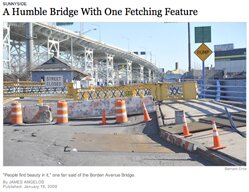
Photography by Bernard Ente
Borden Avenue Bridge 

|

|

|
 Borden Avenue Bridge Celebration (requires Flash) |
||
Borden Avenue Bridge Fast Facts
History
The original Borden Avenue Bridge over Dutch Kills was a wooden bridge built as part of the general construction of Borden Ave. in 1868, connecting East Second Street in Long Island City with D Street in Blissville and to Greenpoint Ave. This original bridge was built during a time when local government had little power and say in New York State. The responsibility of such a project was given to a commission appointed by the legislature.
In 1874, the wooden bridge was replaced by an ?Iron Swing Bridge? as part of a streets and avenues improvement program.
By the late 1890s, the Department of Bridges had been formed and recommended in 1902 the need for a new bridge, due to higher traffic volumes, which the Department of War approved. During the first half of the 20th century, the department?s responsibility was to oversee the construction of public works over rivers and harbors.
The Iron-Swing Bridge was removed in 1906 and construction began shortly on a new retractile bridge, a bridge with a superstructure designed to move horizontally either longitudinally or diagonally from ?closed? to ?open? position, the portion acting in cantilever being counterweighted by that supported on rollers. This new bridge opened on March 25th, 1908 at a cost of $157,606. The deck?s original design consisted of creosote-treated wood blocks, with two trolley tracks in the roadway.
The movable bridge opens and closes through horizontal translation of the entire superstructure. Its trapezoidal shaped frame is mounted on nine wheeled trucks which roll on four pairs of crane rails.
Operation of the Borden Avenue Bridge is performed through the Control House. The Control House is a three-story cast-in-place concrete structure originally designed and built along with the bridge.
In closing, the bridge?s general appearance for the most part resembles its 1908 appearance and is only one of four retractile type bridges in the United States, including one of two in New York City.
Recent Media


